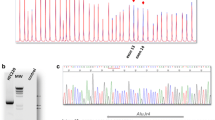Abstract
The molecular diagnostics of genetically conditioned disorders is based on the identification of the mutations in the predisposing genes. Hereditary cancer disorders of the gastrointestinal tracts are caused by mutations of the tumour suppressor genes or the DNA repair genes. Occurrence of recurrent mutation allows improvement of molecular diagnostics. The mutation spectrum in the genes causing hereditary forms of colorectal cancers in the Polish population was previously described. In the present work an estimation of the frequency of the recurrent mutations of the APC gene was performed. Eight types of mutations occurred in 19.4% of our FAP families and these constitute 43% of all Polish diagnosed families.
Similar content being viewed by others
Introduction
Molecular diagnostics of cancer predisposition is very important for the medical treatment of the patient and persons belonging to the high risk group. Molecular studies enable the detection of mutation carriers and release from unreasonable stress of persons from the group with increased risk of cancer occurrence. The mutation spectrums in the genes predisposing to colorectal cancer in the Polish population have been described [1–4]. In the present work we focused on recurrent mutations of the APC gene causing FAP [5].
Familial adenomatous polyposis (FAP) is characterized by the appearance of numerous polyps in the large intestine. Untreated polyps lead to the development of colorectal cancer before age of 50 years. FAP is a genetically determined disorder, inherited in an autosomal dominant manner. The correlation between mutations of the APC gene and the occurrence of familial adenomatous polyposis was described in 1991 [1, 2] and since then, mutations of the APC gene have been investigated in research centres leading to identification of various mutation types. APC gene mutations arise de novo in 1 per 10,000 newborns. The APC gene is localized on chromosome 5q21 and consists of 21 exons. Mutations of the APC gene, in most cases, are small deletions or insertions with the most frequent mutations, in the greater part of the described populations, being the AAAGA deletion at codon 1309 and the ACAAA deletion at codon 1061.
Patients
Clinical diagnoses of FAP patients were conducted in collaborating genetic centres or gastroenterology clinics in the place of residence of patients. So far, samples of DNA belonging to 280 Polish FAP families have been collected in the DNA bank of Polish FAP families established in 1997 at the Institute of Human Genetics, Polish Academy of Science in Poznan.
Molecular methods
DNA was extracted from peripheral blood cells by the classical phenol purification method and entire coding sequence of APC gene was screened for mutations by PCR-HD and SSCP methods in 280 probands. DNA fragments showing heteroduplex or additional pattern in SSCP analysis were sequenced by direct PCR product sequencing and analyzed using a MegaBace 500 sequencer according to the manufacturer's specifications.
Results and discussion
We identified 72 mutations in 124 of our 280 FAP families and observed eight types of recurrent mutations. The mutations and age of onset are presented in Table 1. Two of them were localized in exon 11 and the remaining six in the 3' part of exon 15. The most frequent mutation, 3927–3931delAAAGA, occurred in twenty-eight families (10%); the second one was 3183–3187delACAAA, occurring in eight families (2.8%); and the third most frequent mutation was 3202–3205delTCAA, detected in 5 families (1.7%). In our FAP patients Y500X occurred in four families (1.4%) while Q978X was detected in three families. Each of the remaining four types of mutation occurred in two families and the frequencies of these mutations were below one percent.
In the Human Mutations Database at the Institute of Medical Genetics in Cardiff http://www.hgmd.cf.ac.uk/ac/gene.php?gene=APC, considered the most representative population in the world, seven hundred mutations are listed for the APC gene. The most important mutation of the APC gene is 3927–3931delAAAGA. The frequency of these mutations varies depending on populations. The mutation reports describe the frequency of this mutation from 0% in northwest Spain, 2.4% in the Australian population, 5% in Dutch, 7% in Israeli to 16% in the group of Italian FAP patients [6–9]. The second most frequent mutation, 3183–3187delACAAA, is reported with frequency ranging from 0% in northwest Spain, 1.5% in Israeli populations to 8.4% in Australia [6–9]. A study of over 100 Dutch families revealed equal frequency of those two most frequent mutations (3927–3931delAAAGA and 3183–3187delACAAA) [10]. The largest studies of APC gene mutations were performed on a German population [11, 12]. The latest published report in 2005 involved the analysis of over 1000 patients. In comparison to this study, the representative study of mutation frequency in the neighbouring population indicated two times higher frequency of 3927–3931delAAAGA, whereas a difference in frequency of 3183–3187del-ACAAA was not observed (Germany 3.8%, Poland 2.7%). The frequency of 3202–3205delTCAA was equal (1.7%) in both populations. In worldwide comparison differences in the frequency of mutations were observed. The Polish population of FAP patients belongs to the group where 3927–3931delAAAGA occurred with higher frequency, whereas the frequency of mutation 3183–3187del-ACAAA occurred with medium frequency in comparison with other populations. The two recurrent mutations localized on exon 11 were observed only in the Polish population. In our two unrelated families with 1490–1491insT brain tumours were observed. Additionally in one family desmoid tumours occurred [10, 13]. Another mutation (Q978X) did not occur with higher frequency as described for other populations [14]. In our FAP patient group Q283X, which occurs with frequency of 4.5% in UK FAP patients, was not observed [13]. Recurrent mutations occurred in 54 Polish FAP families. Screening for these mutations permitted us to diagnose 19% of all families in our population but eight types of mutations constitute 43.5% of all our diagnosed families. The mutation study in our population should involve these eight mutations to improve molecular diagnostics of the APC gene.
The study was financed by grant 2P05A10728 from the Ministry of Science and Higher Education.
References
Plawski A, Lubiński J, Banasiewicz T, Paszkowski J, Lipinski D, Strembalska A, Kurzawski G, Byrski T, Zajaczek S, Hodorowicz-Zaniewska D, Gach T, Brozek I, Nowakowska D, Czkwaniec E, Krokowicz P, Drews M, Zeyland J, Juzwa W, Słomski R: Novel germline mutations in the adenomatous polyposis coli gene in Polish families with familial adenomatous polyposis. J Med Genet 2004, 41: e11. 10.1136/jmg.2003.010215
Skrzypczak M, Podralska M, Heinritz W, Froster UG, Lipinski D, Slomski R, Plawski A: The MYH gene status in Polish FAP patients without the APC gene mutations. Heredit Cancer Clin Pract 2006, 4: 43–47.
Kurzawski G, Suchy J, Ktadny J, Safranow K, Jakubowska A, Elsakov P, Kucinskas V, Gardovski J, Irmejs A, Sibul H, Huzarski T, Byrski T, Debniak T, Cybulski C, Gronwald J, Oszurek O, Clark J, Góźdź S, Niepsuj S, Słomski R, Pławski A, Łacka-Wojciechowska A, Rozmiarek A, Fiszer-Maliszewska Ł, Bebenek M, Sorokin D, Stawicka M, Godlewski D, Richter P, Brozek I, Wysocka B, Jawień A, Banaszkiewicz Z, Kowalczyk J, Czudowska D, Goretzki PE, Moeslein G, Lubiński J: Germline MSH2 and MLH1 mutational spectrum in HNPCC families from Poland and the Baltic States. J Med Genet 2002, 39: E65. 10.1136/jmg.39.10.e65
Kurzawski G, Suchy J, Lener M, Kłujszo-Grabowska E, Ktadny J, Safranow K, Jakubowska K, Jakubowska A, Huzarski T, Byrski T, Debniak T, Cybulski C, Gronwald J, Oszurek O, Oszutowska D, Kowalska E, Góźdź S, Niepsuj S, Słomski R, Pławski A, Łacka-Wojciechowska A, Rozmiarek A, Fiszer-Maliszewska Ł, Bebenek M, Sorokin D, Sasiadek MM, Stembalska A, Grzebieniak Z, Kilar E, Stawicka M, Godlewski D, Richter P, Brozek I, Wysocka B, Limon J, Jawień A, Banaszkiewicz Z, Janiszewska H, Kowalczyk J, Czudowska D, Scott RJ, Lubiński J: Germline MSH2 and MLH1 mutational spectrum including large rearrangements in HNPCC families from Poland (update study). Clin Genet 2006, 69: 40–47. 10.1111/j.1399-0004.2006.00550.x
Groden J, Thliveris A, Samowitz W, Carlson M, Gelbert L, Albertsen H, Joslyn G, Stevens J, Spirio L, Robertson M, et al.: Identification and characterization of the familial adenomatous polyposis coli gene. Cell 1991, 66: 589–600. 10.1016/0092-8674(81)90021-0
Gavert N, Yaron Y, Naiman T, Bercovich D, Rozen P, Shomrat R, Legum C, Orr-Urtreger A: Molecular analysis of the APC gene in 71 Israeli families: 17 novel mutations. Hum Mutat 2002, 19: 664. 10.1002/humu.9037
Schnitzler M, et al.: Frequency of codon 1061 and codon 1309 APC mutations in Australian familial adenomatous polyposis patients. Hum Mutat 1998, (Suppl 1):S56-S57.
Ruiz-Ponte C, Vega A, Carracedo A, Barros F: Mutation analysis of the adenomatous polyposis coli (APC) gene in northwest Spanish patients with familial adenomatous polyposis (FAP) and sporadic colorectal cancer. Hum Mutat 2001, 18: 355. 10.1002/humu.1198
Varesco L, Gismondi V, James R, De Benedetti L, Heouaine A, Biticchi R, Masetti E, Bertario L, Sala P, Grammatico P, et al.: APC gene mutations in Italian familial polyposis coli patients. Cancer Detect Prev 1993, 17: 279–281.
Luijt RB, Khan PM, Vasen HF, Tops CM, van Leeuwen-Cornelisse IS, Wijnen JT, Klift HM, Plug RJ, Griffioen G, Fodde R: Molecular analysis of the APC gene in 105 Dutch kindreds with familial adenomatous polyposis: 67 germline mutations identified by DGGE, PTT, and southern analysis. Hum Mutat 1997, 9: 7–16. 10.1002/(SICI)1098-1004(1997)9:1<7::AID-HUMU2>3.0.CO;2-8
Friedl W, Caspari R, Sengteller M, Uhlhaas S, Lamberti C, Jungck M, Kadmon M, Wolf M, Fahnenstich J, Gebert J, Möslein G, Mangold E, Propping P: Can APC mutation analysis contribute to therapeutic decisions in familial adenomatous polyposis? Experience from 680 FAP families. Gut 2001, 48: 515–521. 10.1136/gut.48.4.515
Friedl W, Aretz S: Familial adenomatous polyposis: experience from a study of 1164 urelated German plyposis patients. Heredit Cancer Clin Pract 2005, 3: 87–114.
Wallis Y, Morton D, McKeown C, Macdonald F: Molecular analysis of the APC gene in 205 families: extended genotype-phenotype correlations in FAP and evidence for the role of APC amino acid changes in colorectal cancer predisposition. J Med Genet 1999, 36: 14–20.
Björk J, Akerbrant H, Iselius L, Bergman A, Engwall Y, Wahlström J, Martinsson T, Nordling M, Hultcrantz R: Periampullary adenomas and adenocarcinomas in familial adenomatous polyposis: cumulative risks and APC gene mutations. Gastroenterology 2001, 121: 1127–1135. 10.1053/gast.2001.28707
Author information
Authors and Affiliations
Rights and permissions
Open Access This article is published under license to BioMed Central Ltd. This is an Open Access article is distributed under the terms of the Creative Commons Attribution 2.0 International License (https://creativecommons.org/licenses/by/2.0), which permits unrestricted use, distribution, and reproduction in any medium, provided the original work is properly cited.
About this article
Cite this article
Pławski, A., Podralska, M. & Słomski, R. Recurrent APC gene mutations in Polish FAP families. Hered Cancer Clin Pract 5, 195 (2007). https://doi.org/10.1186/1897-4287-5-4-195
Received:
Accepted:
Published:
DOI: https://doi.org/10.1186/1897-4287-5-4-195




